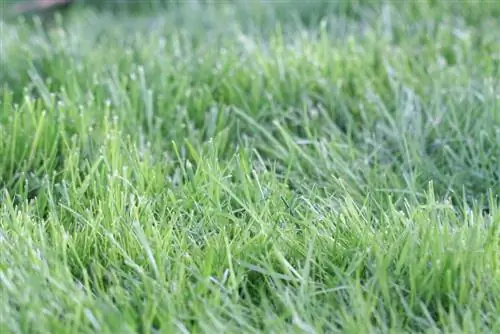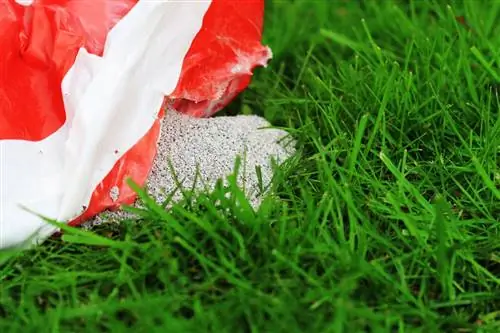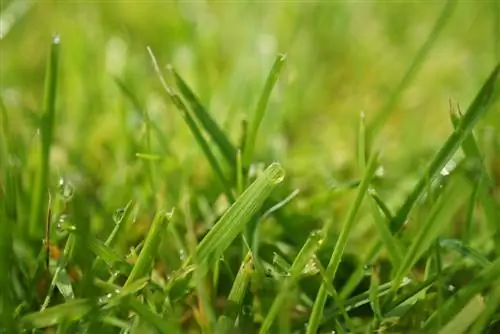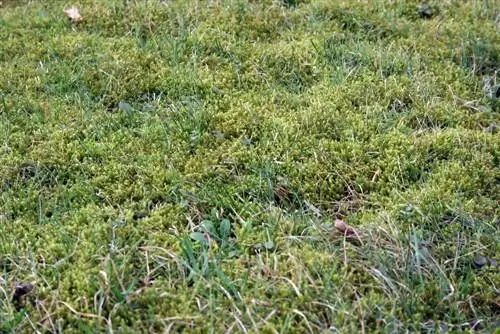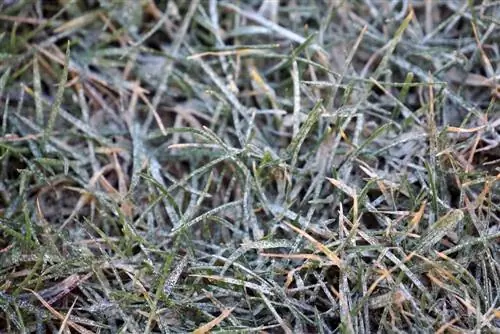- Author admin [email protected].
- Public 2023-12-17 03:39.
- Last modified 2025-01-24 12:45.
It takes a lot of work to create a beautiful garden with he althy grass. However, with proper fertilization and liming you can achieve good results. Not all soils require lime, but in many cases they create the conditions for a he althy growing lawn. In principle, fertilizing and liming at the same time is possible, but should be avoided if possible.
Which nutrients the lawn needs
For a beautiful lawn with a dense, green grass cover, fertilization is essential. However, you should not just use any fertilizer as you see fit, but rather tailor its composition to the composition of your garden soil and the needs of your plants. Not every lawn needs the same nutrients; instead, different types of grass and their mixture require an equally individual nutrient composition. Basically, however, all plants need the same six nutrients for strong and he althy growth:
- Nitrogen
- Phosphorus
- Potassium
- Oxygen
- Carbon
- Hydrogen
There are also various minerals and trace elements that are only needed in small quantities, but are nevertheless essential for the metabolism and nutrition of plants.
Why targeted fertilization is so important
As a rule, grasses, like all other plants, obtain the components carbon, hydrogen and oxygen from the air or sunlight through photosynthesis. The remaining required nutrients nitrogen, phosphorus and potassium are found in the soil. While air and sun are always present, the latter substances do not renew themselves without help. Year after year, plants use these nutrients without returning them to the cycle in any way. Targeted fertilization replaces the used ingredients. Both under-supply and over-fertilization have serious consequences for plant he alth.
What role do the different nutrients play in fertilizer
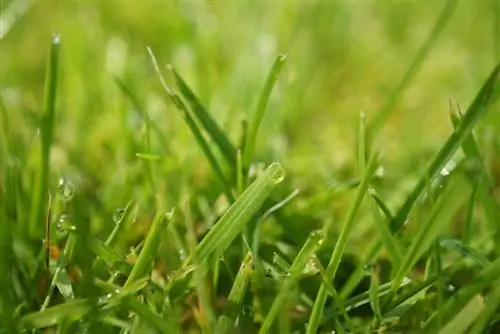
Each of the nutrients mentioned has a very specific task in the plant's metabolism.
Nitrogen
Nitrogen is a main component of chlorophyll and therefore an essential part of the photosynthesis process. A balanced nitrogen balance leads to thicker and taller grasses with he althier leaves. Nitrogen can also speed up the growth of plants.
Phosphorus
Phosphorus is also a component of chlorophyll, which is so important for the plant organism and, thanks to the increased production of starch and oils, helps in the development of firm and strong roots. The substance also strengthens the plants' resistance to many diseases.
Potassium
Potassium is another important element with a variety of benefits that contribute to the overall he alth quality of the plant. Potassium improves and strengthens root growth, is essential for building important proteins and fights harmful diseases.
Benefits of fertilizer
Fertilizer not only supplies the soil with the main nutrients mentioned, but also allows the soil to be better aerated and increases its ability to store water. Fertilizers also provide plants with other important nutrients such as calcium, sulfur, magnesium, boron, copper and iron.
Acid soil
However, the numerous benefits of fertilizing can only be effective if the soil has the right level of acidity. Its acidity is a measure of the amount of hydrogen present and is graded according to pH, which is measured on a logarithmic scale ranging from 0 to 14. A pH value of 7 is considered neutral, less than 7 is considered acidic and more than 7 is considered alkaline or basic. Most soils have a pH of 5.5 to 10. A pH between 6 and 7 is recommended for he althy plant growth. When soil pH falls below 6, various harmful side effects occur, including:
- Aluminium toxicity: Aluminum becomes soluble at low pH values. Aluminum restricts root growth and limits the availability of water and nutrients.
- Nutrient Availability: When acidity is high, plants cannot absorb nitrogen, phosphorus and potassium. This inhibits proper growth.
- Microbial activity: Under acidic conditions, bacteria and fungi cannot break down organic matter and circulate nutrients through the soil.
You can easily determine the pH value of your soil using a commercially available strip test. A soil test carried out in the laboratory is significantly more expensive, but also produces more precise results.
How fertilizer affects soil pH
The more hydrogen the soil contains, the more acidic it is. Its acidity increases steadily due to nitrogen-based plant nutrition, especially if you use a fertilizer based on ammonium nitrogen or overdose it. Over-fertilization always leads to acidification of the soil, which is why you must first determine the specific needs through a thorough soil analysis.
Mowing the lawn also acidifies the soil
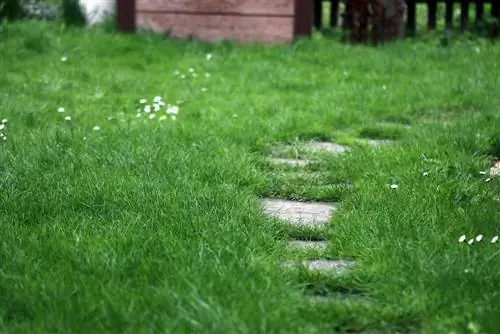
Furthermore, regular mowing of the lawn also leads to soil acidification. The plants themselves are slightly alkaline and have a higher pH than the soil. In a natural environment, dead plant material decomposes in the slightly acidic soil, restoring a he althy pH balance. If the plants are mowed down, the cycle is interrupted and the balancing act is never carried out. That's why the soil always remains slightly acidic.
Lime reduces the acidity of the soil
To neutralize the soil and restore pH balance, the gardener must apply calcium from time to time. The easiest and cheapest way to do this is to lime the soil. Lime is made from ground limestone, a gray sedimentary rock composed primarily of calcium carbonate and magnesium carbonate. The components calcium and magnesium neutralize the acidity of the soil by reacting with the acidic components hydrogen and potassium, leaving neutralized clay, carbon dioxide and water instead.
How is lime used?
Dolomite lime is the most common type of lime sold for lawns and comes in either powder or pellet form. Lime powder is exactly what it sounds like: a fine, white powder that you sprinkle over your lawn. The finer the lime is ground, the larger its surface area is. This increase in surface area, in turn, leads to a faster reaction time with the ground. Under no circumstances should you apply the lime powder on a windy day and wear a face mask while doing so. However, less dirt causes lime in pellet form, which you simply distribute evenly on the floor and which fulfills the same function as the powder.
Should you apply lime or fertilizer first?
In general, it is best not to apply lime and fertilizer at the same time. But what criteria do you use to decide whether to apply lime or fertilizer first?
The pH balance of your soil will largely determine which of the two products is applied first. Consider the goals of any growth supplement: Fertilizer is added to the soil to increase the level of nutrients available to plants. Lime, in turn, is said to reduce acidity and thus make nutrients more easily accessible to plants. When deciding between lime and fertilizer, it is therefore important to take the pH of the soil into account.
When does lime have to be applied first?

If your soil has a high acid content, you should lime first and only fertilize after a certain waiting period. Lime takes time because the deacidification process is not a quick one. The finer the lime is ground, the faster it reacts with the soil and the less time there is between liming and fertilization. If your soil is highly acidic, apply approximately 50 kilograms of lime per 100 square meters of lawn. If lime is added only to maintain pH, it is recommended to use a smaller amount - about 20 kilograms of lime per 100 square meters.
The best time to lime
Autumn is generally considered the best time to apply lime as it provides ample time for the slow chemical reaction to occur. You should also avoid applying lime in extreme heat or frost, as this significantly reduces its effectiveness.
When does the fertilizer have to be applied first?
If you are planting new grass seed, however, you should apply the fertilizer before the lime. If there is a lack of nutrients in the soil, the seeds cannot germinate and grow effectively. No matter what the acidity of the soil is, if there are no nutrients in the soil, the plants will not grow to their full potential. Wait at least a week to ten days before finally applying lime. Allow the plants the time necessary to absorb the nutrients contained in the fertilizer. Adding lime increases the effectiveness of the fertilizer already in the soil. The roots of the plants, which should be starting to grow at this point, will benefit from the additional boost from the lime.
Under what conditions can lime and fertilizer be applied at the same time?
If the pH of the soil is already neutral, you do not need to apply fertilizer and lime at different times. To save time and money, you can do both at the same time. The fertilizer provides nutrients to the soil immediately, while the lime is slowly released over time and maintains the pH. Apply fertilizer and lime separately so that both are evenly distributed over the entire lawn. First go over the lawn with the fertilizer and then lime.
Overdose leads to illness
If your lawn or plant field already has a neutral pH, you only need to apply lime every two years. An excess of lime can lead to iron chlorosis, which results in yellow or even dead grass. Overapplication of fertilizer can cause chemical burns, thatch buildup, and an increase in pests and diseases in your lawn.
Tip: Many gardeners swear by mature compost instead of lime for neutralization, which also raises the pH value. Compost also has the advantage that it supplies the lawn with valuable nutrients.

